I am implementing SVM using scikit package in python. I am having difficulty while interpreting the "alpha i" values in plot_separating_hyperplane.py
import numpy as np
import pylab as pl
from sklearn import svm
# we create 40 separable points
np.random.seed(0)
X = np.r_[np.random.randn(20, 2) - [2, 2], np.random.randn(20, 2) + [2, 2]]
Y = [0] * 20 + [1] * 20
# fit the model
clf = svm.SVC(kernel='linear')
clf.fit(X, Y)
print clf.support_vectors_
#support_vectors_ prints the support vectors
print clf.dual_coef_
#dual_coef_ gives us the "alpha i, y i" value for all support vectors
Sample output
Dual_coef_ = [[ 0.04825885 0.56891844 -0.61717729]]
Support Vectors =
[[-1.02126202 0.2408932 ]
[-0.46722079 -0.53064123]
[ 0.95144703 0.57998206]]
Dual_coef_ gives us the "alpha i * y i" values. We can confirm that summation of "alpha i * y i" = 0 (0.04825885 + 0.56891844 - 0.61717729 = 0)
I wanted to find out the "alpha i" values. It should be easy, since we have "alpha i * y i" values. But i'm getting all "alpha i's" to be negative. For example, the point (0.95144703, 0.57998206) lies above the line (see link). So y = +1. If y = +1, alpha will be -0.61717729. Similarly for point (-1.02126202, 0.2408932) lies below the line. So y = -1, and hence alpha = -0.04825885.
Why am I getting alpha values to be negative? Is my interpretation wrong? Any help will be appreciated.
For your reference,
For the Support Vector Classifier (SVC),
Given training vectors , i=1,..., n, in two classes, and a vector such that , SVC solves the following primal problem:

Its dual is

where 'e' is the vector of all ones, C > 0 is the upper bound, Q is an n by n positive semidefinite matrix,  and
and  is the kernel. Here training vectors are mapped into a higher (maybe infinite) dimensional space by the function .
is the kernel. Here training vectors are mapped into a higher (maybe infinite) dimensional space by the function .